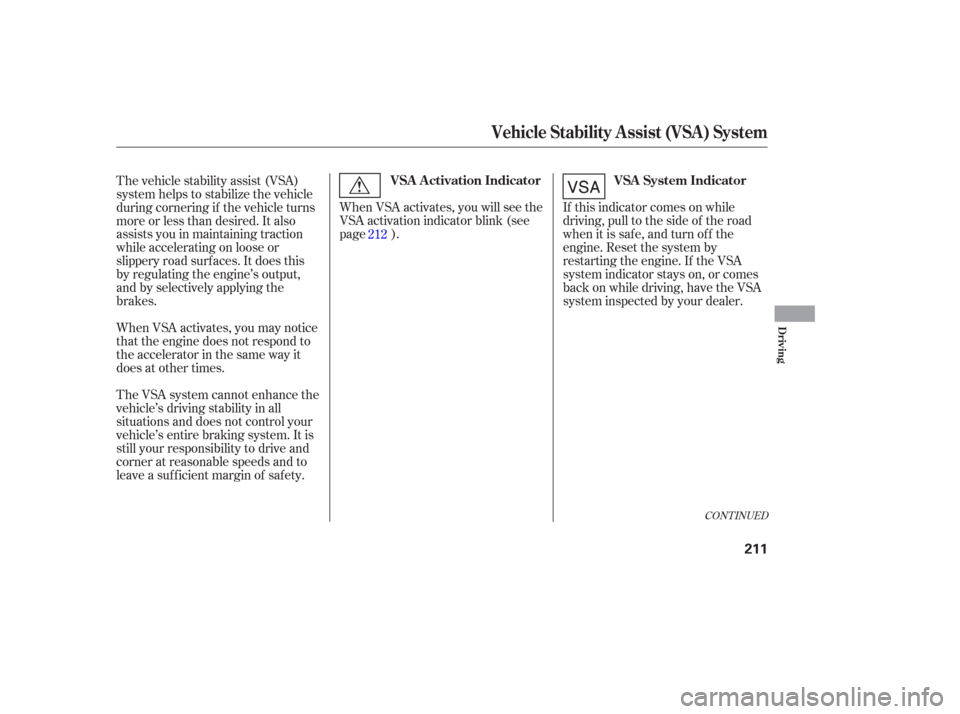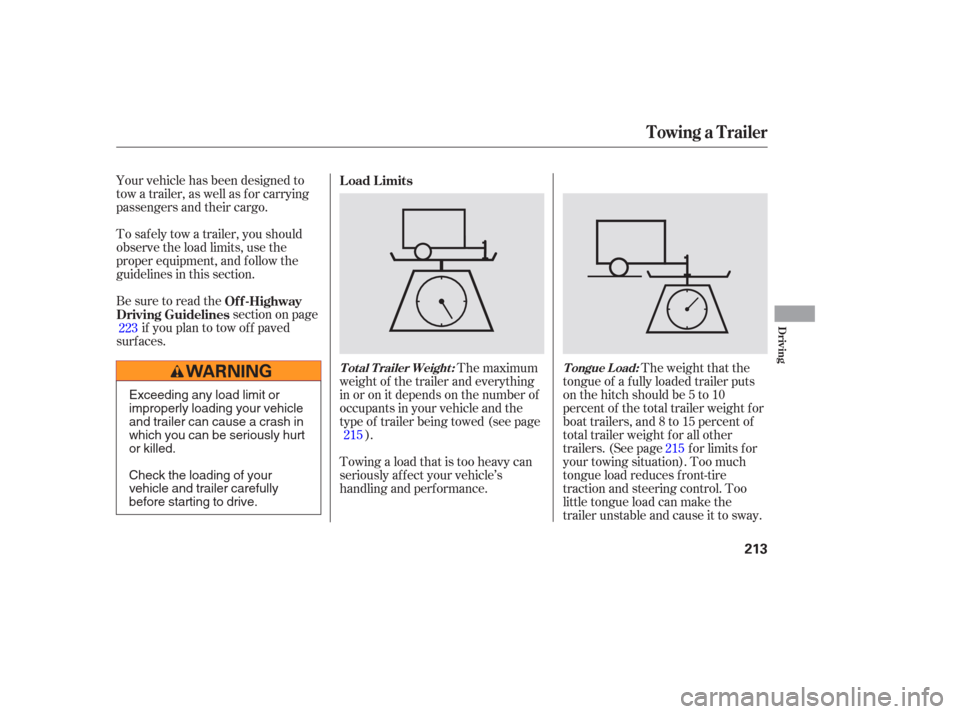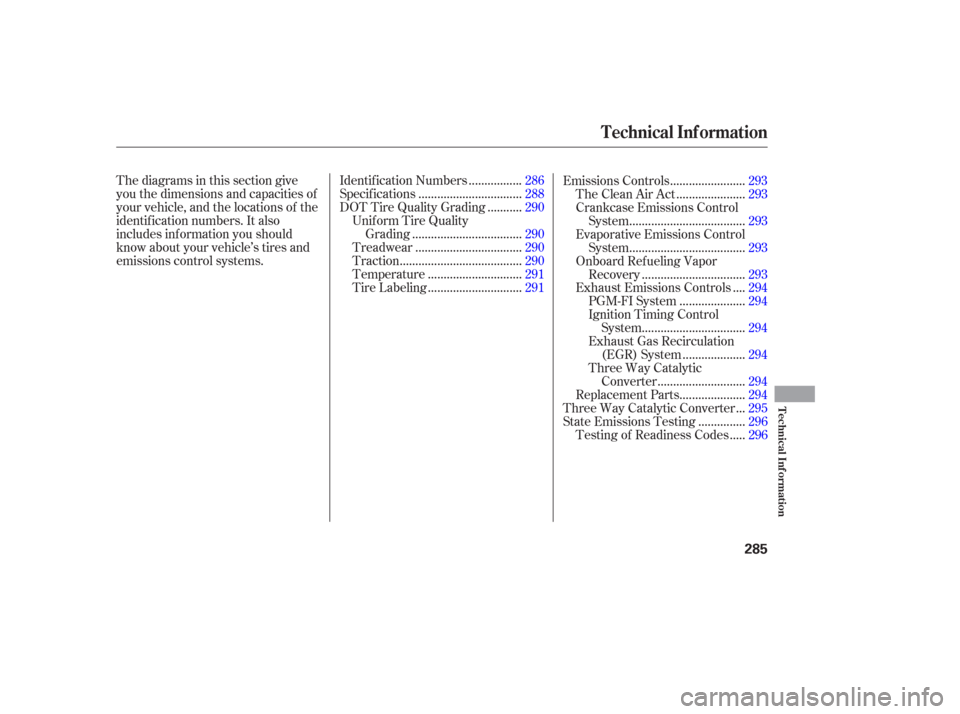Page 213 of 316

When VSA activates, you will see the
VSA activation indicator blink (see
page ).If this indicator comes on while
driving, pull to the side of the road
when it is saf e, and turn of f the
engine. Reset the system by
restarting the engine. If the VSA
system indicator stays on, or comes
back on while driving, have the VSA
system inspected by your dealer.
The vehicle stability assist (VSA)
system helps to stabilize the vehicle
during cornering if the vehicle turns
more or less than desired. It also
assists you in maintaining traction
while accelerating on loose or
slippery road surf aces. It does this
by regulating the engine’s output,
and by selectively applying the
brakes.
When VSA activates, you may notice
that the engine does not respond to
the accelerator in the same way it
does at other times.
The VSA system cannot enhance the
vehicle’s driving stability in all
situations and does not control your
vehicle’s entire braking system. It is
still your responsibility to drive and
corner at reasonable speeds and to
leave a sufficient margin of safety. 212
CONT INUED
VSA A ctivation Indicator
VSA System Indicator
Vehicle Stability Assist (VSA) System
Driving
211
Page 215 of 316

Your vehicle has been designed to
tow a trailer, as well as f or carrying
passengers and their cargo.
To saf ely tow a trailer, you should
observe the load limits, use the
proper equipment, and f ollow the
guidelines in this section.
Be sure to read thesectiononpage
if you plan to tow of f paved
surf aces.
The maximum
weight of the trailer and everything
in or on it depends on the number of
occupants in your vehicle and the
type of trailer being towed (see page ).
Towing a load that is too heavy can
seriously af f ect your vehicle’s
handling and perf ormance. Theweightthatthe
tongue of a f ully loaded trailer puts
on the hitch should be 5 to 10
percent of the total trailer weight for
boat trailers, and 8 to 15 percent of
total trailer weight for all other
trailers. (See page f or limits f or
your towing situation). Too much
tongue load reduces f ront-tire
traction and steering control. Too
little tongue load can make the
trailer unstable and cause it to sway.
223
215 215
Load Limits
Off-Highway
Driving Guidelines
Towing a Trailer
T ot al T railer Weight : T ongue L oad:
Driving
213
Exceeding any load limit or
improperly loading your vehicle
and trailer can cause a crash in
which you can be seriously hurt
or killed.
Check the loading of your
vehicle and trailer carefully
beforestartingtodrive.
Page 287 of 316

Thediagramsinthissectiongive
you the dimensions and capacities of
your vehicle, and the locations of the
identif ication numbers. It also
includes inf ormation you should
know about your vehicle’s tires and
emissions control systems.................
Identif ication Numbers . 286
................................
Specif ications .288
..........
DOT Tire Quality Grading . 290
Unif orm Tire Quality ..................................
Grading .290
.................................
Treadwear .290
......................................
Traction .290
.............................
Temperature .291
.............................
Tire Labeling .291 .......................
Emissions Controls .293
.....................
The Clean Air Act .293
Crankcase Emissions Control ....................................
System .293
Evaporative Emissions Control ....................................
System .293
Onboard Ref ueling Vapor ................................
Recovery .293
...
Exhaust Emissions Controls . 294
....................
PGM-FI System .294
Ignition Timing Control ................................
System .294
Exhaust Gas Recirculation ...................
(EGR) System . 294
Three Way Catalytic ...........................
Converter .294
....................
Replacement Parts . 294
..
Three Way Catalytic Converter . 295
..............
State Emissions Testing . 296
....
Testing of Readiness Codes . 296
T echnical Inf ormation
T echnical Inf ormation
285
Page 292 of 316

�µ
Quality grades can be f ound where
applicable on the tire sidewall
between the tread shoulder and the
maximum section width. For
example:
All passenger vehicle tires must
conf orm to Federal Saf ety
Requirements in addition to these
grades. The treadwear grade is a compara-
tive rating based on the wear rate of
the tire when tested under controlled
conditions on a specif ied government
test course. For example, a tire
graded 150 would wear one and one-
half (1 1/2) times as well on the
government course as a tire graded
100. The relative perf ormance of
tires depends upon the actual condi-
tions of their use, however, and may
depart signif icantly f rom the norm
due to variations in driving habits,
service practices, and dif f erences in
road characteristics and climate.
The traction grades, f rom highest to
lowest, are AA, A, B, and C. Those
grades represent the tire’s ability to
stop on wet pavement as measured
under controlled conditions on
specif ied government test surf aces
of asphalt and concrete. A tire
marked C may have poor traction
perf ormance.
Warning: The traction grade
assignedtothistireisbasedon
straight-ahead braking traction tests,
and does not include acceleration,
cornering, hydroplaning, or peak
traction characteristics.
The tires on your vehicle meet all
U.S. Federal Saf ety Requirements.
All tires are also graded f or
treadwear, traction, and temperature
perf ormance according to
Department of Transportation
(DOT) standards. The f ollowing
explains these gradings.
DOT Tire Quality Grading (U.S. Vehicles)
Unif orm T ire Quality Grading
T readwear 200
Traction AA
Temperature A Treadwear
Traction AA, A, B, C
290